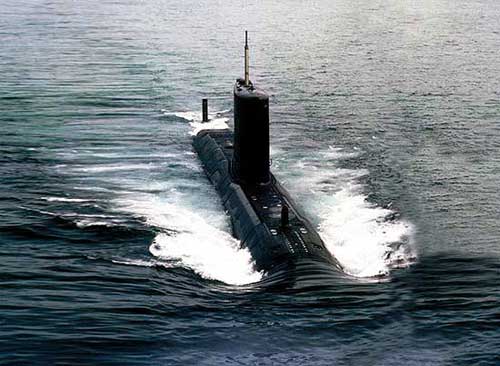 by Bob Ciminel October 09, 2004
The Chicoutimi is one of four mothballed Victoria-class diesel-electric submarines the Royal Navy sold to Canada. According to news reports, the Chicoutimi had an electrical fire while transiting from the United Kingdom to Canada.  Photo courtesy Royal Canadian Navy
Electrical fires on a submarine present the crew with two problems. First, everything on the submarine runs on electricity. True, the diving planes and rudder are hydraulically-operated, but the hydraulic pumps run on electricity. As if losing electrical power isn't enough, the smoke from an electrical fire is dense, pitch black, acrid, and toxic. And, as the fire burns, it consumes the oxygen the crew needs to survive the "people tank." Modern submarines have a breathing air system with hose stations spaced throughout the boat. (Note: Although submarines are technically "ships," they are traditionally referred to as boats.) Using quick-disconnect fittings, crewmembers can travel the length of the boat or remain at their watch stations even with the boat completely filled with smoke. I am assuming the Chicoutimi had a similar system, although I am basing that assumption purely on my knowledge of U.S. submarines. In addition to the physical hazards the fire presents to the submarine and crew, there is also a tactical hazard. What makes the submarine such an awesome weapon is its ability to remain submerged and undetected. With an onboard fire, the only way the crew can get the smoke out of the boat is to come up to periscope depth, raise the snorkel and either start the sub's diesel engines or operate the low pressure blower. The diesels draw air from within the hull and push it out through the back of the snorkel mast while fresh air comes in through the front of the mast. The blower can also draw in air from the snorkel mast, but it typically exhausts into the ballast tanks that surround the submarine. With the submarine at periscope depth, operating either of these components produces sufficient noise to detect the submarine from miles away. The last option is to surface the boat, open the hatches, and ventilate the affected spaces. I haven't found any solid details about the location of the fire aboard the Chicoutimi. Some reports say it started in an electrical panel; others say it was in a switchgear cabinet. The distinction between those two locations is important. Typically, an electrical panel will contain circuit breakers similar to those in a house, whereas a switchgear cabinet will contain large distribution breakers and operate at higher voltages. The physics of electrical fires is pretty simple; the higher the voltage, the hotter the fire. You can be sure that both Canada and the Royal Navy will form investigation boards to determine the cause of the fire. In this case, most of the crew survived, which is clearly not the norm for most submarine accidents.
Author's Note: If you are
interested in learning more about submarines, I highly recommend
you read "The
Complete Idiot's Guide to Submarines", by Michael DiMercuio
and Michael Benson. It is written in layman's terms, and with
a sense of humor. Here's a link to the book at Amazon.com:
|